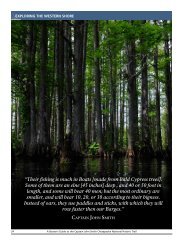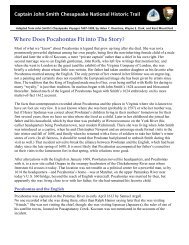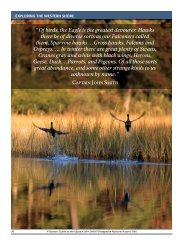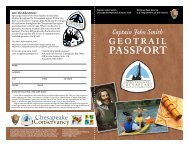Draft Interpretive Plan Join the adventure! - Captain John Smith ...
Draft Interpretive Plan Join the adventure! - Captain John Smith ...
Draft Interpretive Plan Join the adventure! - Captain John Smith ...
Create successful ePaper yourself
Turn your PDF publications into a flip-book with our unique Google optimized e-Paper software.
Decision-makers<br />
To successfully promote, develop and manage <strong>the</strong> Trail, it is critical to secure <strong>the</strong><br />
involvement of community, business and agency leaders. Ongoing collaboration with<br />
leaders and policy-makers will aid in forging important relationships and obtaining<br />
resources necessary for long-term growth and management of <strong>the</strong> Trail.<br />
Partners Identified in Trail Legislation<br />
Two partnership entities are linked to <strong>the</strong> Trail by law. The enabling legislation for <strong>the</strong><br />
<strong>Captain</strong> <strong>John</strong> <strong>Smith</strong> Chesapeake National Historic Trail specifies that <strong>the</strong> Trail shall be<br />
administered “in coordination with” <strong>the</strong> Chesapeake Bay Gateways and Watertrails<br />
Network and <strong>the</strong> Chesapeake Bay Program.<br />
Chesapeake Bay Gateways and Watertrails Network (CBGN) – As mentioned<br />
previously, CBGN provides a framework for development of <strong>the</strong> National Historic Trail<br />
with its array of Bay watershed parks, wildlife refuges, historic sites, museums,<br />
educational institutions, existing water trails and o<strong>the</strong>r assets. Trail-specific<br />
Memorandums of Understanding are in process with nearly one hundred existing<br />
Gateways. A preliminary list of Gateways associated with <strong>the</strong> Trail is in Appendix K.<br />
Chesapeake Bay Program - The Chesapeake Bay Program is a regional partnership that<br />
has coordinated and conducted <strong>the</strong> restoration of <strong>the</strong> Chesapeake Bay since 1983.<br />
Partners include <strong>the</strong> U.S. Environmental Protection Agency, representing <strong>the</strong> federal<br />
government; <strong>the</strong> U.S. Department of Agriculture; <strong>the</strong> states of Delaware, Maryland, New<br />
York, Pennsylvania, Virginia and West Virginia; <strong>the</strong> District of Columbia; <strong>the</strong><br />
Chesapeake Bay Commission, a tri-state legislative body; and advisory groups of citizens,<br />
scientists and local government officials. The National Park Service’s Chesapeake Bay<br />
Office is part of <strong>the</strong> Chesapeake Bay Program, providing leadership in education and<br />
interpretation to foster citizen stewardship of <strong>the</strong> Bay.<br />
Federal Agencies<br />
U. S. Environmental Protection Agency (EPA) – One of <strong>the</strong> original signers to <strong>the</strong> 1983<br />
Chesapeake Bay Agreement, <strong>the</strong> EPA is <strong>the</strong> primary representative for <strong>the</strong> federal<br />
government for <strong>the</strong> Chesapeake Bay Program. The EPA coordinates federal, state, and<br />
local Bay restoration efforts and authorities throughout <strong>the</strong> watershed and provides<br />
environmental planning and financial assistance, implements and coordinates science,<br />
modeling, data collection, assessment, monitoring, and outreach, and develops and makes<br />
available information pertaining to <strong>the</strong> environmental quality and living resources of <strong>the</strong><br />
Chesapeake Bay ecosystem. The EPA and <strong>the</strong> NPS have a long-standing Memorandum<br />
of Understanding that commits both agencies to collaborate on Chesapeake Bay<br />
restoration and conservation efforts.<br />
44








